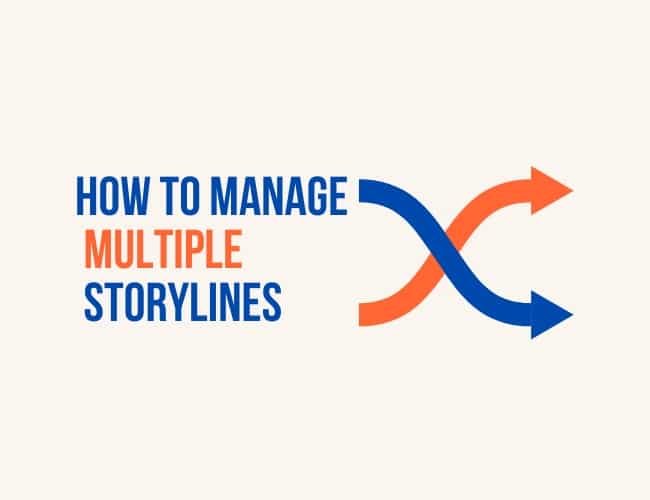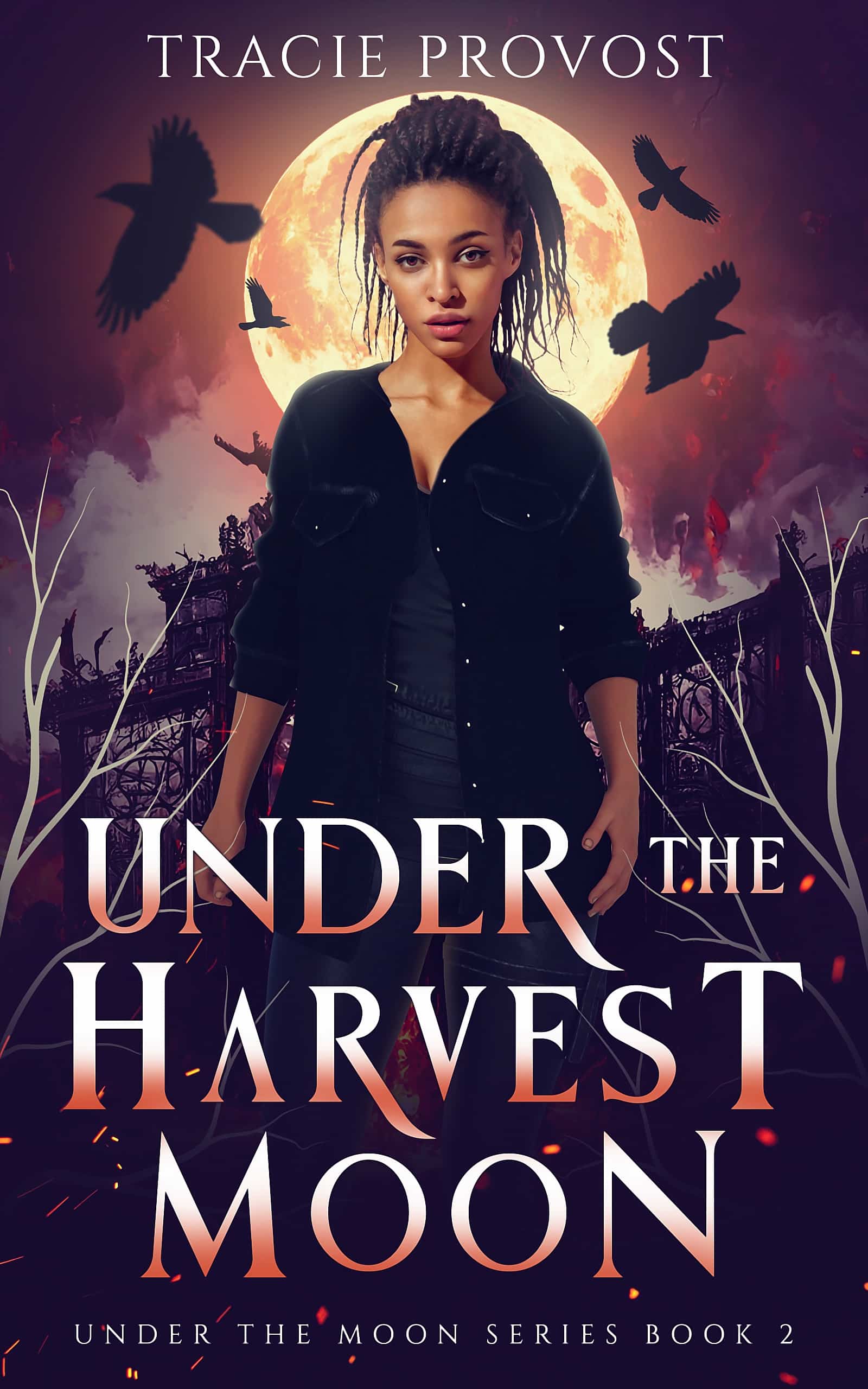Most full length books or films will have multiple storylines, a primary plot and at least one secondary plot. But keeping all those storylines straight can be a challenge. What are multiple storylines and how can you manage them to tell a terrific story?

What are multiple storylines?
Multiple storylines refer to the narrative technique in which a story is told through two or more distinct plots. They may operate independently or interact with one another throughout the narrative.
This approach allows writers to explore complex themes, develop character arcs, and create a richer storytelling experience.
Key Characteristics:
- Independent and Intertwined Plots: Each storyline may initially seem separate but is designed to converge at critical moments, particularly during the climax. This convergence ensures that both plotlines contribute to the overall narrative impact and thematic depth.
- Character Interaction: In stories with intertwined plots, characters from different storylines often know each other or have relationships that affect the story. Their interactions can drive the story forward and deepen the readers' or viewers' investment in the characters' journeys.
- Thematic Resonance: Multiple storylines can reflect or comment on each other, enhancing the overarching themes of the work. By juxtaposing different experiences or viewpoints, the writer can explore a theme from multiple angles, creating a more nuanced discussion.
- Structural Complexity: Managing multiple storylines requires careful plotting to ensure coherence. Writers may adopt various methods, such as alternating chapters, weaving narratives together, or focusing on one storyline before shifting to another, to maintain clarity.
- Narrative Rhythm and Pacing: A well-structured approach to multiple storylines allows for varied pacing and tension-building. Switching between storylines at pivotal moments can heighten suspense and keep the audience engaged.
In summary, multiple storylines in fiction and screenwriting serve as a tool for creating unique stories. They can help you deepen reader or viewer investment in characters and give you opportunities to explore your theme or ideas from multiple perspectives.
The key is to keep readers or viewers engaged in both the main plotline as well as any additional storylines you add. Let's look at how to manage them.
Do I have multiple storylines in my book?
Recognize that most full length books, tv shows, or films will have multiple storylines, even if the secondary or subplot is subtle. Here at The Write Practice, we help writers figure out those plot lines using our free Plot Type Assessment.
You can read all about the nine Plot Types here, but basically, you know what kind of story you are writing by identifying what the character wants, and then matching that with the value.
So in an adventure story like Star Wars where Luke wants to save Princess Leia, the galaxy, and his life, the main storyline is an adventure plot where the value is life versus death. The majority of scenes revolve around whether or not they will survive.
But there is also at least one other storyline as Luke comes of age, stepping out of the world he knows into the much larger world of the Jedi. That secondary storyline is a coming of age plot with all the tropes and conventions that follow it.
You could also argue that Darth Vader has his own storyline because he has a clear goal: protect and expand the Empire.
Vader's plotline neatly intersects with Luke's because they are pitted against each other with similar goals. Both are pursuing the MacGuffin of R2-D2 and ultimately Princess Leia who represents the larger resistance to the Empire for control of the galaxy.
How to Manage Multiple Plot Lines
In typical TV storyline fare, a single episode will usually have two plot lines, referred to as the A-story and the B-story. Occasionally there will be a third line, known as the C-story, and if the writers are feeling particularly ambitious that day, they might even squeeze a D-story in there. Often times, if you miss the C- and D-stories, you won't really have missed anything until about ten episodes later when that action becomes important.
This happens in literature as well, as anyone who has read any of the Song of Ice and Fire series can attest. A consequence of having a cast of characters is that you will have a lot of plot lines as well. If you find yourself in that situation, here are a few ways to manage those plot lines.
1. Make the characters relevant to each other's plots.
If you have multiple characters entwined in the same plot line, that cleans up the action and makes it much easier for the reader to follow what's going on.
Even if you are writing a dual timeline plot, you have to find ways to make those characters intersect with each other's stories.
One question you can ask: Where do my plot lines converge or intersect?
Make sure the characters involved in those plot lines matter to each other, even if they are foes (i.e. Luke versus Darth Vader).
2. Introduce breaks when the character point of view changes.
If you are writing dual or multiple point-of-view characters, make sure you have clear breaks to let the reader know which POV character's plot line they are in.
For example, in dual POV romance, one chapter might be told in first person or third person limited from the heroine's perspective. The next chapter might be in first or third person limited from the hero's point-of-view. They are marked clearly by chapter breaks and often the character's name.
If you're writing from a third person omniscient standpoint, you can give the reader insight into any character's head that you please. If you take that approach, then make sure it's clear when the point of view changes, whether it's an act break or the start of a new chapter. The less work you make for your reader, the longer they'll stick with you to see what's coming next.
3. Make the plots relevant to each other.
In addition to making the characters significant to each other's story lines, try weaving the plots together so they come to a head at the climax of your story.
Maybe the resolution to one plot leads directly to the climax of another plot, or all of the plots meet at one point and suddenly your reader is hit with the significance of everything that has happened in the previous 200-500 pages. This gives your story a sense of unity.
Balance is key when writing multiple plot lines as well. Your readers will not look favorably upon your work if you introduce a character's conflict, and then don't come back to it for 200 pages. Readers want to come along on the journey, so don't leave them out in the cold.
Even if you don't like to outline your storylines before writing, once you have a draft, it's worth taking the time to breakdown your story structure to see how the multiple plots work together as you revise.
Keep in mind too that the plot lines exist to show character development, so you need an arc running through each.
If you're going to create a new plot line, commit to it, and give it significance. If you're just writing an extra one for the sake of writing it, it's probably best left out
What are some of your favorite works with multiple running plot lines? Share in the comments.
PRACTICE
Take 15 minutes. In a few sentences, summarize two subplots for your work in progress.
Post your subplot summaries, along with a brief summary of your story's main plot, in the Pro Practice Workshop. And if you post, be sure to give feedback on the subplot summaries of a few other writers.
Good luck!



In my book Greybo: A Dwarven Legend I’ve got three major plots
Series:
The book introduces elements of the series storyline.
Story:
The book tells of the struggles of a melancholy dwarf to overcome the past.
Story in a Story:
The book tells an intricate story that is just as deep that is a source of conflict and reflection for the dwarf, pushing him to face his past.
The tricky part is interweaving the plot lines. I’ve found that symbols and metaphors transcend the plot lines, so coming up with a handful of them that really to 2 or more of the plot lines has been my challenge.
One of my biggest issues is that the transition into the “story within a story” is really hard to make.
When finished, this will be my first book. I feel like I’ve taken on large challenges that most beginning writers would not have taken on with a first novel. But, I feel to grow as a writer, we must challenge ourselves.
You can read more at http://vozey.wordpress.com/
“Eye of the Mare” implies a dominating matriarchal figure. (or is my imagination running away with me?) The other title, “Greybo, a Dwarvan Legend”, harks back to Tolkiens’ book.
I hope this helps.
I would say the later would be more accurate. It has roots in his work, but I’ve also taken my own direction.
Eye of the Mare or Eye of the Black Horse or Night of the Mare. I hate picking titles.
When I first thought of it as a symbol, I decide to make a prototype book cover by robbing various artists on the internet.
Thanks for your input. It helps. Let me know what the cover makes you think and whether you like it. That would help, too.
This cover certainly catches the eye. And makes me wonder what the book could be about.
I suppose that is good. The fire deters any thought that it is like The Black Stallion. Haha
But then again, I doubt it screams fantasy either.
Maybe if I add a de-emphasized and robed character to its back, still keeping the horse’s eye the focal point, I could achieve everything I want with it.
Is it bad when the back cover intro doesn’t have anything to do with the front cover, or is misleading at best? I mean the horse does appear in the story, just not for quite some time.
Anyway, I’m only a fourth done with my novel, I’ve got lots more to write, so I wonder why I’m worrying about this in the first place!
Thanks for your feedback. I really appreciate it.
I have the plot, and subplot. Of course, they overlap.
The plot tells the story of one character’s life now a turf war has ended, thanks to his rather ruthless efforts and actions. The subplot is the story of his sister falling in love with her brother’s enemy, who wants my MC dead.
Main plot: Daughter and father haven’t gotten along since childhood. Daughter is now turning 30 and wants nothing to do with him. Father never understood how he became so estranged from his daughter and tries to make amends.
Subplot: Father helps daughter move across country. They encounter another young lady and her young daughter. The father befriends this young duo, perhaps a little too much.
Subplot: After moving, the daughter meets the man of her dreams. He comes from a broken home and yearns for a father figure. Could the daughter’s estranged father become his father figure?
Does the father’s new relationship with the young lady and daughter that he met lead to an affair? Does his daughter see the relationship between her father and this mother/daughter as a relationship she should have had with her father and she envies her father all the more?
Does her new boyfriend’s past of a broken home and unstable childhood lead her to understand her father’s caring ways or does it make the boyfriend a character who cannot forget his past and his anger and he takes it out on her? Does her father come to her rescue then, proving his love for his daughter?
I see many possible story lines with these subplots.
You’ve exploited all the possibilities these sub-plots have to offer. Isn’t the trick to ask Why, When, Who, How, etc?
Maryna Melnick, returning home after working in Europe for a few years, finds her domineering father, the reason she left home in the first place, waiting to control her life again.
At her new job with a group of enthusiasts who restore old airplanes, she befriends Lance Grady, their unofficial test pilot.
The pride of their fleet, an old Ford Trimotor, crashes in a neighbouring country while on a testing flight. Whilst earlier undergoing a routine maintenance overhaul, Solomon Villa, the other partner controlling the company, had tinkered with the engines. But instead of Lance taking her up for the test flight, one of their other pilots had been given the job.
What puzzles everybody is the twenty-odd young passengers aboard who were also killed. (Human trafficking.)
In the end Solomon Villa’s links with Maryna’s father, which had resulted in Maryna being expelled by European immigration authorities and returned to her father’s custody, are revealed..
The plot:
Tiana and Lairke have much in common. They were both born in the last month of the 4th Age, they have the same black hair and blue/green eyes.
But Tiana is a peasant.
And Lairke is a prince.
When Tiana’s past is revealed, they find that their lives have been intertwined for much longer than they imagined.
Together, they set out to discover a secret which will change their lives — one which could bring down the kingdom.
Subplot: When the odyssey of the two young people put the kingdom at risk, Lairke’s older brother Forge — heir to the throne — is faced with an insurmountable decision. Save his country? Or save his brother?
Subplot: Believing that Lairke and Tiana had become rebels who, knowing their past, could wreak havoc on the capitol city of Bergkvist, King Stolt hires one known as the Archer, a treacherous man from a shady people with an even shadier past. He held the secret to the art of the Black Arrows, and if Lairke and Tiana truly had uncovered the long-hidden secrets of their birth, the Black Arrows alone could stop them.
Subplot: Thrad, Captain of the Guard of Bergkvist, has a wife at home. She is pregnant with their first child after many years of wishing for a baby. When the King orders him and his squadron to follow Forge to the Fords of Ahlstrom where a battle may await, *spoilers* he must leave his sickly wife carrying a baby who was almost full-term.
*amateur writer!!* (I mean, obviously x) But ehh, I’m doing my best xD
I would totally read this story. It’s funny, because I consider myself an amateur as well, but didn’t all the greats like Charles Dickens and C.S. Lewis start as ‘amateurs’ at one point or another? I hope you use your talent to the best of it’s ability, and continue to challenge yourself because it’s good for you. I think you have great potential with this plot! Don’t let fear hold you back.
PLOT:
Sauvignon wakes up in a dream world called Illusionate without any memories. It’s up to her and friends to discover her past which will ultimately save Illusionate.
SUB PLOTS:
Her friend and eventual love interest Tourniquet is watching out for Sauvignon. He also needs to regain his memories.
Octavia is sent to the by the Dream Doctor to lead her in the right direction. Her plan is stalled by Brian but she returns later in the story to encourage Sauvignon.
The Dream Doctor wants his daughter Sauvignon home and as a soul, helps her journey to save Illusionate even after his death.
Brian, the villian, wants to be the Dream Doctor, and became so by manipulation, and to get rid of the line. To ultimately rule, then destroy Illusionate.
I stumbled upon this post because I was looking for some help with my plot lines. I’m not necessarily writing a novel though, instead I’m writing a screenplay which is a 13 part series so I have a few more plot lines than usual. It consists of 2 main plot points on which actually leads to the murderer and the one about the murderer. Also some plot lines lead to new plot lines as the series moves forward.
MAIN PLOT:
Someone plants the gun that was used to kill Yuki in Markus’ bed room and Jason sets out to find out who the real murderer is, but there are 7 different suspects who could it be?
MAIN PLOT 2:
When Markus is in prison, Jason begins to discover that his live in house maid Gabrielle is harboring a secret and sets out to discover what it is.
SUB-PLOTS:
A: Markus begins to get beaten in jail, but soon makes a new friend and sets out to find out exactly who he is.
B: Lynsay and Frank begin to have relationship issues which ultimately leads to Lynsay asking for a divorce.
C: Before the divorce Frank was having an affair with Mercedes which later leads to him being a suspect for the murder of Yuki.
D: Shiori begins to find pictures of Frank around the house and tries to solve the mystery as to why they are there; However she soon discovers that he is in fact her half brother and that she was adopted. She also discovers that he and Emiko had a fling and that they are harboring another secret (Koichi is actually Franks son).
E: Koichi begins to use drugs; However after much misuse of these drugs he is admitted to Rehab.
I just finished writing 38 pages of plots for everything that could possibly exist in my novel- from the forests to the spirits to the characters to the objects in the story. No stone is without conflict! It might not be noticed, as the main story line will pass by it and overshadow it, but its got so much life and meaning everywhere.
Wow! Your story sounds interesting! Can I take a look at it?